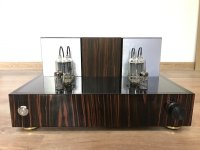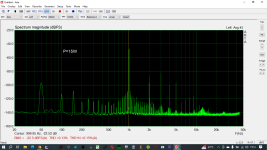One solution i the use of KT150 in UL with 1627I'm interested in building some sort of single-ended triode tube amplifier, probably in a mono power amplifier format. I know enough to know that 15W is a lot to ask of a SET amp, but not enough to know how feasible or infeasible it is. If my expectations need readjusting, then please, adjust away.
This is a circuti I used
the E88C is a single triode
Walter
This is the frequency answer at 10 w with 6 dB od Feedback
There is a resonance at arount 200kHz but is not significative
They never took off for different reasons: the 811 was/is pretty inefficient in all its variants, the 572 less linear than 211/845.Svetlana tried to address this with their SV-811-X and SV-572-X series tubes, but unfortunately they're no longer readily available
And Svetlana stuff have a very short life.hey never took off for different reasons: the 811 was/is pretty inefficient in all its variants, the 572 less linear than 211/845.
Aren't a good tubes as the original ones.
The variation of 572 that was interesting was the 572-3 where you don't have to go in positive grid.
Less was the 10
Out of the reason the 160
Walter
I would personally go for the 211 but it requires 1KV+ anode voltage and a good 10-11K transformer. The rest of the amp is not much different from a typical 8W 300B amp for about 2x output power. It's cheaper than the 845 and the Chinese make pretty good replicas. The basic PSVANE 211 of the HiFi Series is really good, regardless of its moderate price. All one needs to do is make sure it's properly tested and selected. To get more power out of the 211 one has to spend significantly more money and it gets more complicated. The 845 has the advantage that could deliver 15W with just 750V anode voltage but it's more demanding in terms of driver.I'm interested in building some sort of single-ended triode tube amplifier, probably in a mono power amplifier format. I know enough to know that 15W is a lot to ask of a SET amp, but not enough to know how feasible or infeasible it is. If my expectations need readjusting, then please, adjust away.
The 300B PSE is the other obvious choice and can deliver up to 24-25W but, despite the lower anode voltage around 420V, is going to be fairly expensive-to- really expensive. For 15-16W it's cheaper and quite less complex but 4 good 300B's are not cheap. Pick your poison!
GM70 is another option to consider, but plate voltages of 1kV are required. Mu is higher than an 845 and lower than a 211. Good linearity. Graphite plate versions are not terribly expensive, IMHO need to be replaced about every 1200 - 1300 hours of operation. I built a couple of pairs of amps based on GM70 and ran them for 12 years.
EML300B XLS, EML320B XLS, KR 300B XLS
A pair of 300B XLS costs 850 euros
KR costs around 900 eu. pair
A pair of KT150 cost 230 euro. You got more than 10 w rms in se
A pair of KT170 cost 300 euros. You got close to 15 watt rms in se
So it is interesting to know how much our friend want to spend.
In addition there is the costs of OT trafos that can be variable with a ratio of 1:3, knowing the cost oh Hammon 1627SE that is 220 eu. each, not so expensive
Walter
Although a bit more advanced skills are needed, you could also consider a pentode/tetrode SE stage with local feedback, such as cathode or plate to grid feedback, in order to achieve triode like or even better linearity. The main benefits are higher Po to Pd ratio and lower Miller capacitance, permitting driver tubes with higher Rp as drivers.
Starting with an output transformer that has a 0.5dB insertion loss (OK loss):
An 845 has to send 16.8 Watts to the primary of an output transformer to get 15 Watts out of the secondary.
Parallel 300B, 845, and a few other triodes will get you 15 Watts out.
I built a parallel 300B single ended, and used it for the Glass Audio article "Paralleling Tube Effects".
Designing parallel tubes the correct way has good results.
Not paying attention to all the details has bad results for parallel tubes.
Just my opinions and my experience.
An 845 has to send 16.8 Watts to the primary of an output transformer to get 15 Watts out of the secondary.
Parallel 300B, 845, and a few other triodes will get you 15 Watts out.
I built a parallel 300B single ended, and used it for the Glass Audio article "Paralleling Tube Effects".
Designing parallel tubes the correct way has good results.
Not paying attention to all the details has bad results for parallel tubes.
Just my opinions and my experience.
I'm beginning to actually believe that paralleling identical filamentary (without unipotential cathode) triodes with their filaments in opposite polarity will cancel (null by summing to zero) the IM caused by AC powered filaments mixing with signal caused by the valves' even order distortions. But not smart enough to actually say for sure - looks right to me, but I can't trust myself about something this subtle. Hopefully will be able to test within the next year.
Always good fortune,
Chris
Always good fortune,
Chris
We expect tons of 2nd order distortion here...Here is a triode strapped KT88 load line design that provides ≈13.3 watts into the load. Difference between that and 15W is only ≈1/2 a dB.
Best regards!
You said SET, but would you be interested in considering UNSET? That gets you an easy 20+ watts from a cathode driven 6LW6 sweep tube in single ended connection. See George‘s design (of Tubelab fame) in this thread:
https://www.diyaudio.com/community/threads/unset-beta-board-build.376124/
https://www.diyaudio.com/community/threads/unset-beta-board-build.376124/
It’s amazing how little sonic difference there is between 10 and 13 watts or 12 and 15 watts. The amount of work and expense to get just that tiny bit more power is really a huge jump. As the kids say, is the juice worth the squeeze? If your speakers are on the higher efficiency side, above 94db you can hit over 104Db with a 10 watt amp, that’s loud!
These really do sound awesome! It's a very simple amp with a short signal path that are very dynamic.Might want to checkout Skunkie Designs KT 120se monoblock build and video series.
https://www.skunkiedesigns.com/kt120-monoblock
https://m.youtube.com/playlist?list=PLtEhh3UpOsiDh6orcLPoJjPWSy--6g675
Not pure triode and UL strapped, but will give you the power single ended in a simple amplifier.
Dan
I'll second this as a design worth considering. Mine uses inexpensive tubes, will touch 25W just as it starts to clip, and most important sounds great with whatever speakers or music I throw at it.You said SET, but would you be interested in considering UNSET? That gets you an easy 20+ watts from a cathode driven 6LW6 sweep tube in single ended connection. See George‘s design (of Tubelab fame) in this thread:
https://www.diyaudio.com/community/threads/unset-beta-board-build.376124/
- Home
- Amplifiers
- Tubes / Valves
- Feasibility of getting 15W out of a SET tube design?

